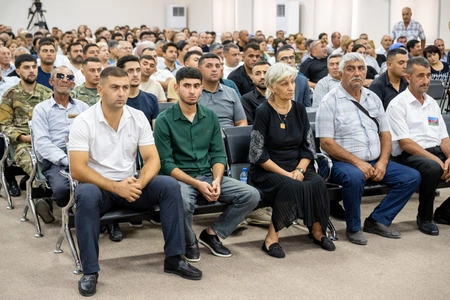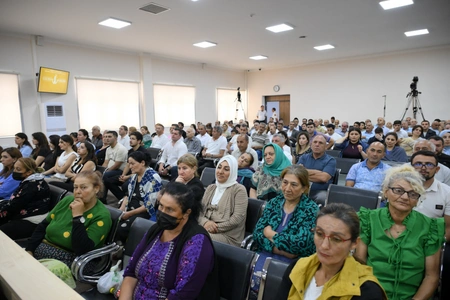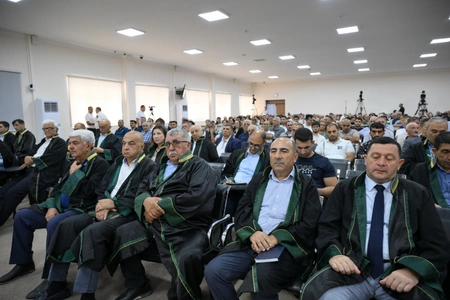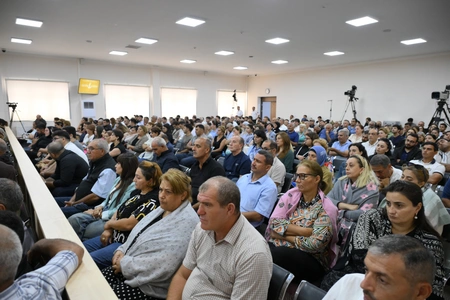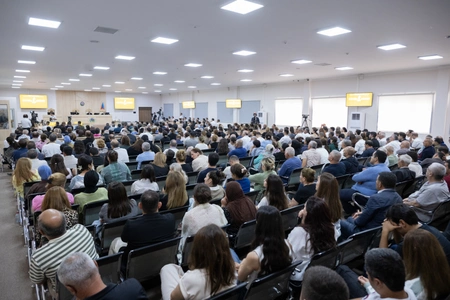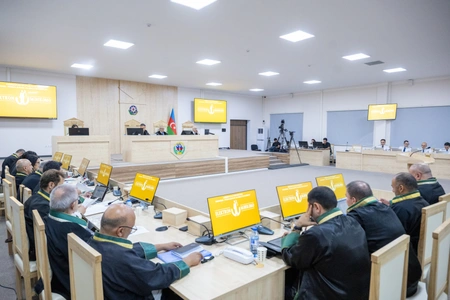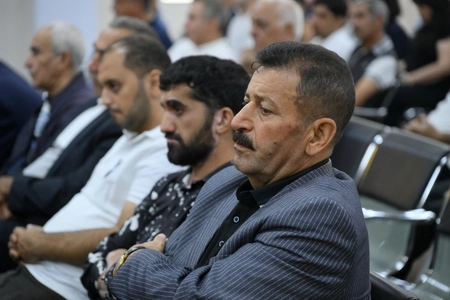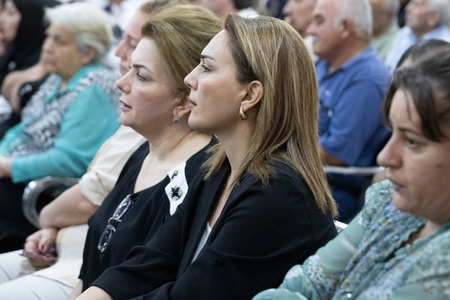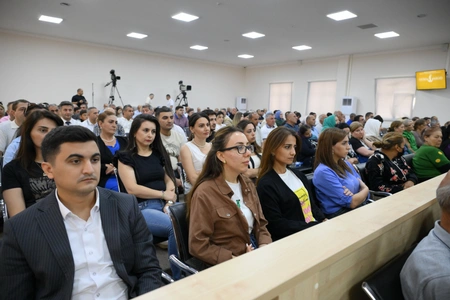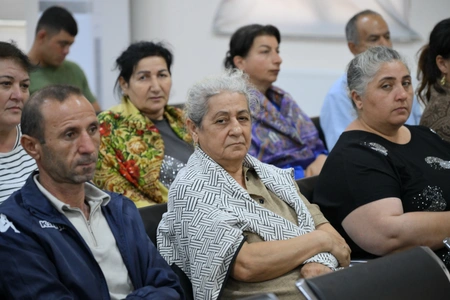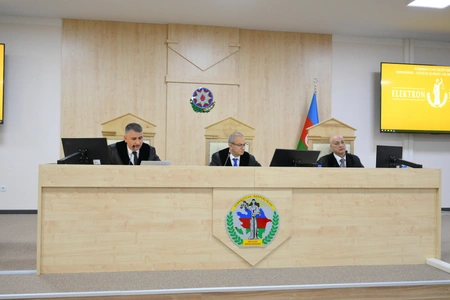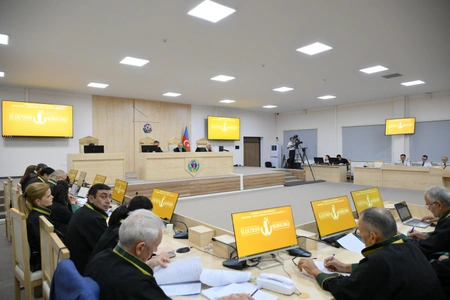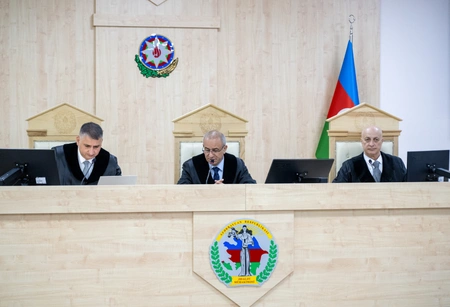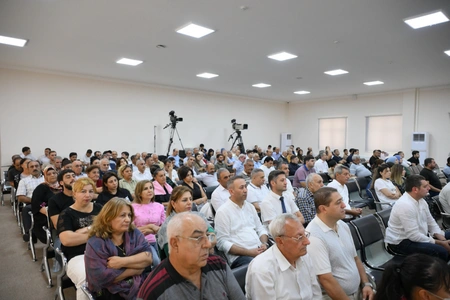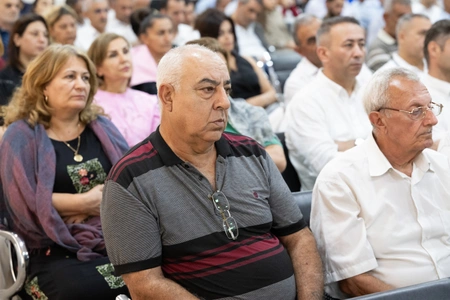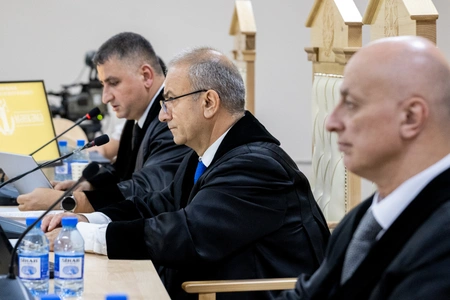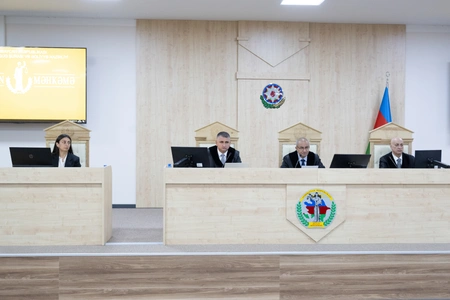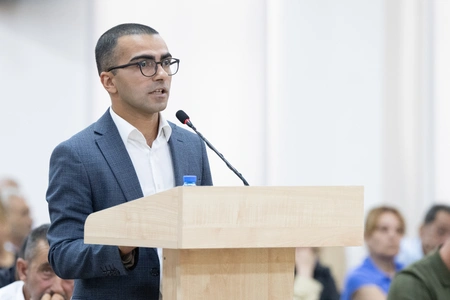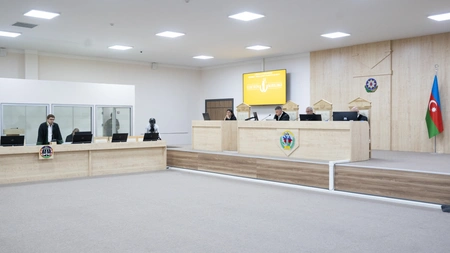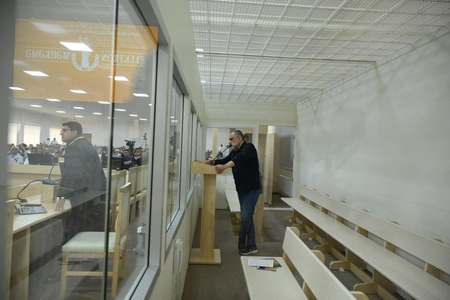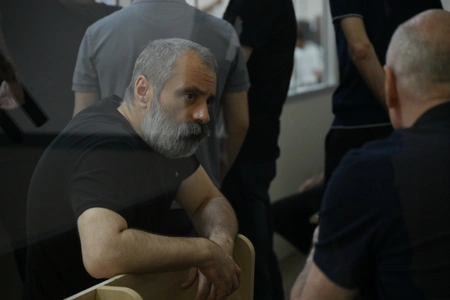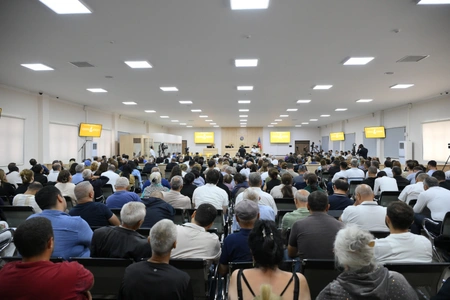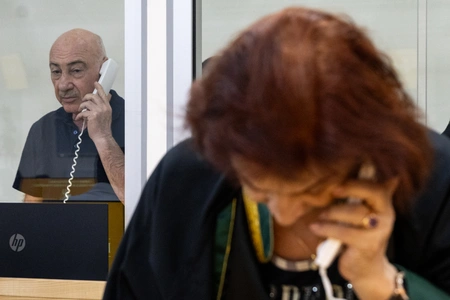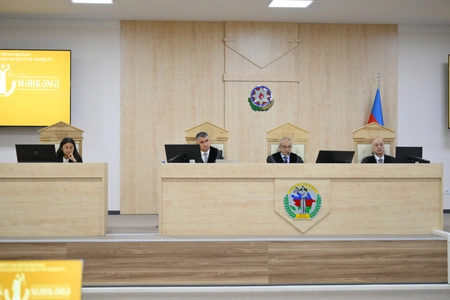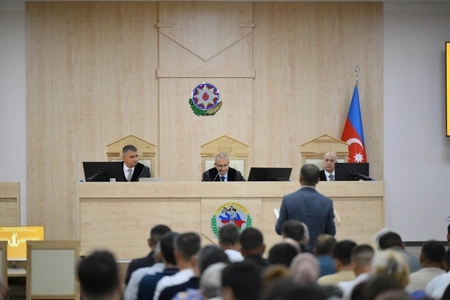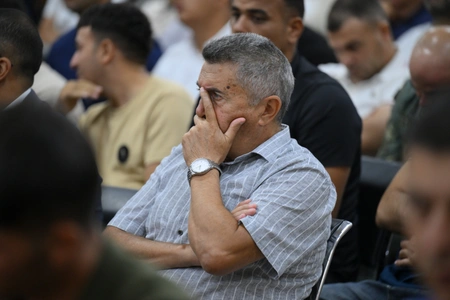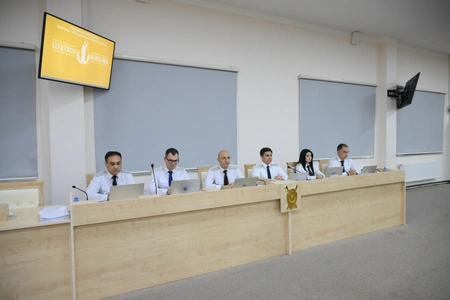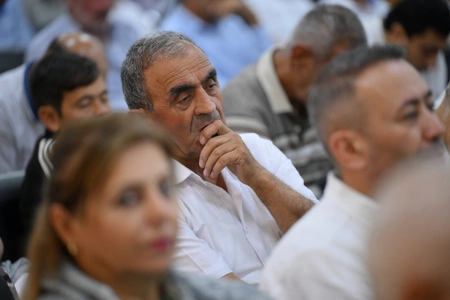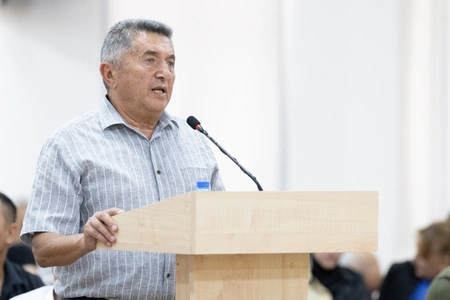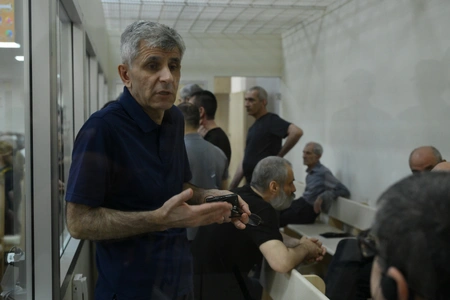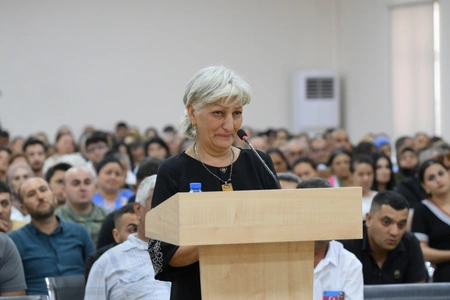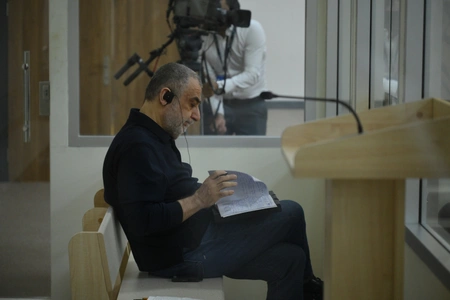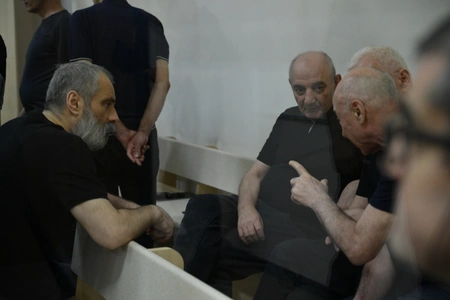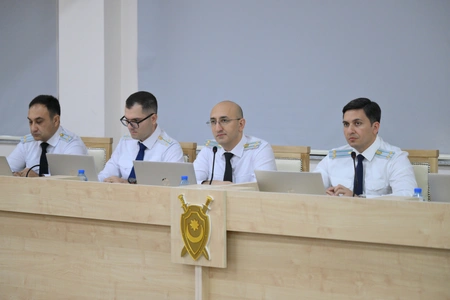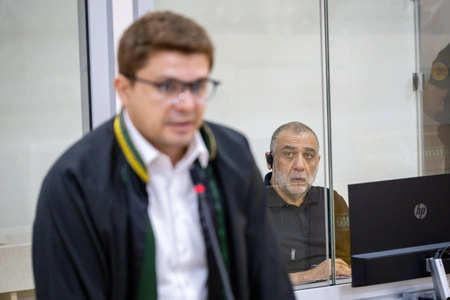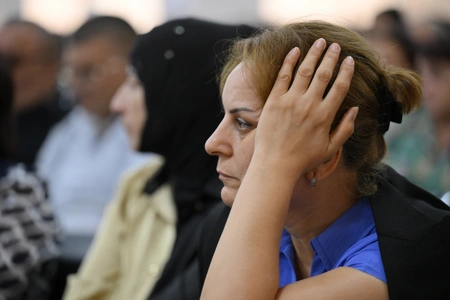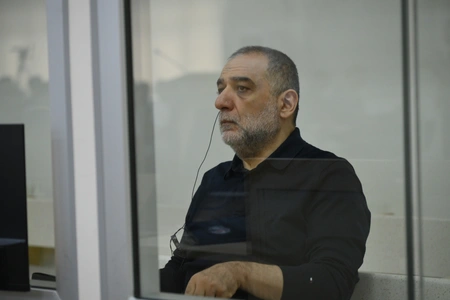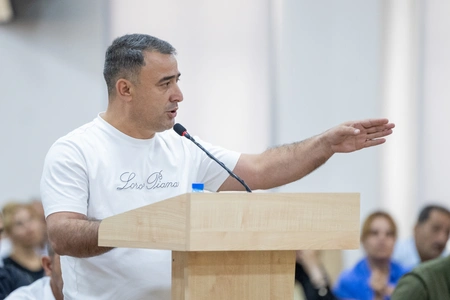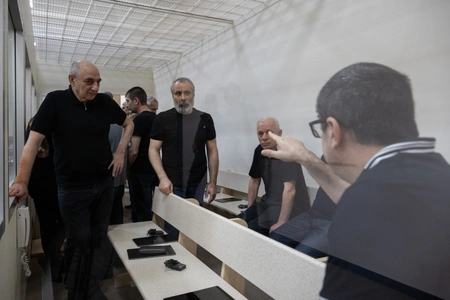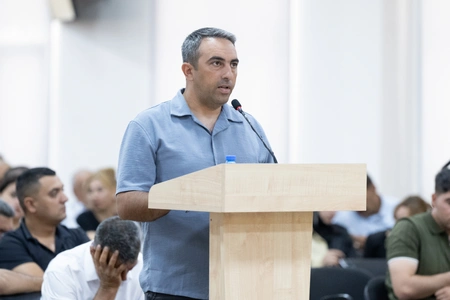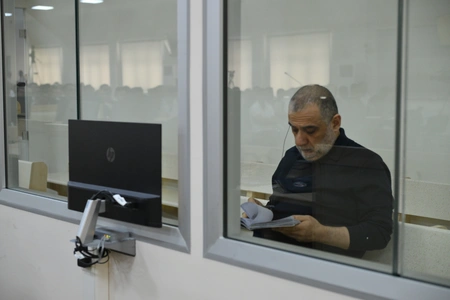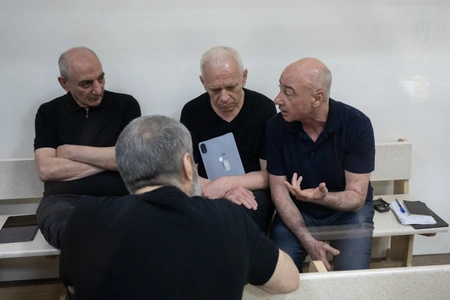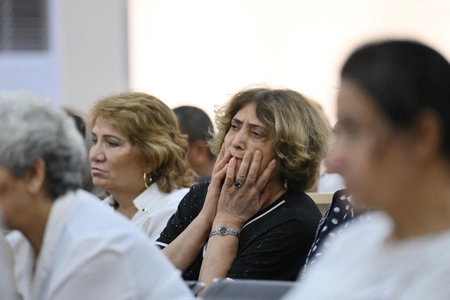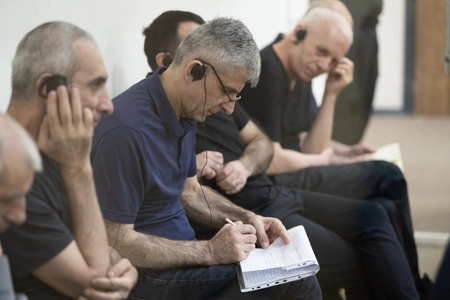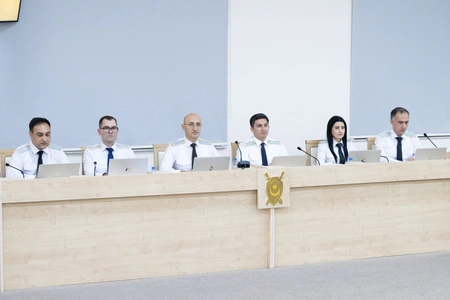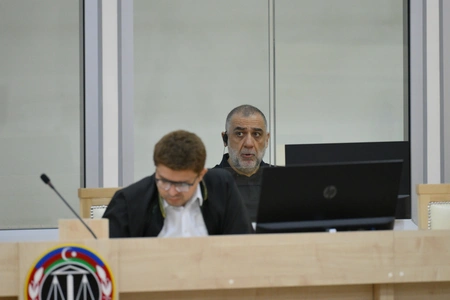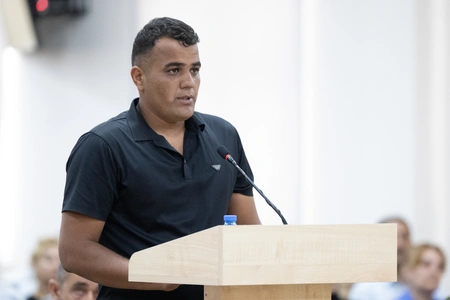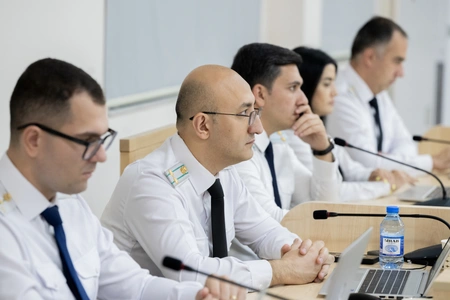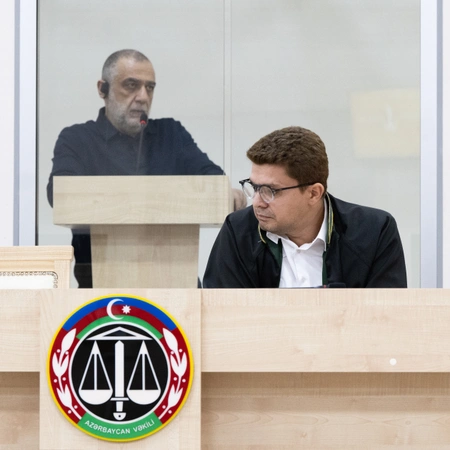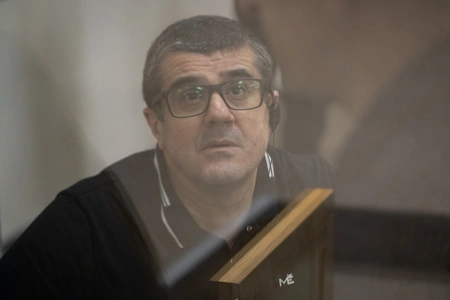Madat Babayan reveals names of Armenian military personnel noted for extreme cruelty during Khojaly genocide in court
- 04 September, 2025
- 21:21
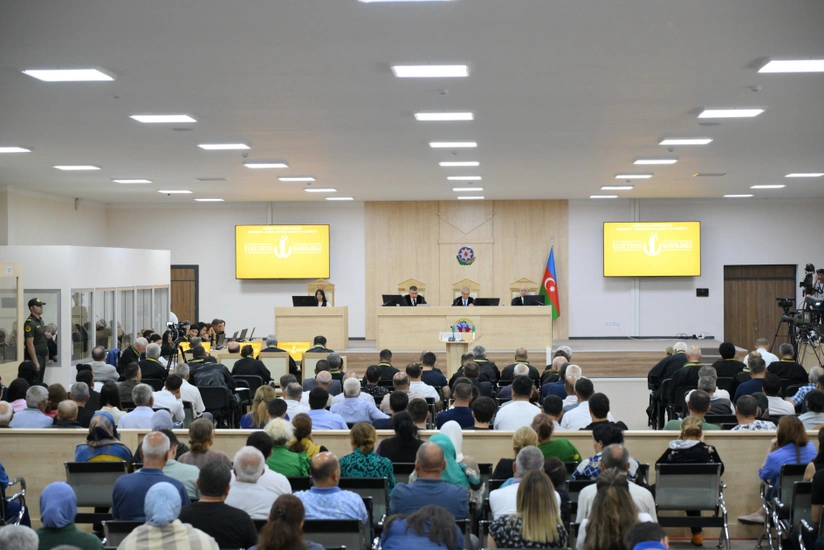
The open court hearing regarding the criminal cases of citizens of the Republic of Armenia - Arayik Harutyunyan, Arkadi Ghukasyan, Bako Sahakyan, Davit Ishkhanyan, David Babayan, Levon Mnatsakanyan, and others continued on September 4, Report informs via AZERTAC.
The defendants are accused of crimes against peace and humanity, war crimes, including the preparation and conduct of an aggressive war, genocide, violation of war laws and customs, terrorism, financing of terrorism, forcible seizure and retention of power, and numerous other crimes resulting from Armenia"s military aggression against Azerbaijan.
The trial, held at the Baku Military Court under the chairmanship of Judge Zeynal Agayev, with judges Jamal Ramazanov and Anar Rzayev (reserve judge Gunel Samadova), ensured that all accused persons were provided with translators in their preferred language and defense lawyers.
The session was attended by the accused, their defense attorneys, some of the victims, their legal heirs and representatives, as well as prosecutors defending the state"s charges.
The court proceedings continued with the reading of the preliminary investigation testimonies and other related documents of the accused Garik Martirosyan.
According to his preliminary investigation testimony, from early 1993 to late 1994, during the 44-day war in 2020, and from January to September 20, 2023, he served at combat posts, firing weapons at Azerbaijani soldiers.
In the Khojaly region, he was part of the "Askeran self-defense units" led by Vitali Balasanyan, joining these military units from early 1993.
After the 44-day war, he heard that the "Askeran District Executive Authority" was providing funds to individuals "protecting villages under its jurisdiction." He visited the authority and received approximately 200,000 Armenian drams (equivalent to $500 USD).
From January 2023, he stood guard at posts in areas of Azerbaijan then occupied by Armenian armed forces, receiving a monthly salary. He was equipped with an AKS automatic rifle during his service. He was captured during Azerbaijan"s anti-terrorist operation on September 19-20, 2023.
Subsequently, the preliminary investigation testimonies and related documents of the accused Gurgen Stepanyan were read.
In his testimony, he stated that he is a citizen of the Republic of Armenia and was conscripted into military service on November 3, 2005, by the military commissariat of Vayk District (formerly Yeghegnadzor Province, Pashali District). He served as a soldier in a military unit located in Hadrut, a settlement then under the occupation of Armenian armed forces.
The military unit was commanded by Colonel Vachagan Nersesyan, with Major Ashot Harutyunyan as battalion commander and Captain Armen Harutyunyan as company commander. The unit"s purpose was to maintain posts in the Fuzuli District, where military personnel served on a rotational basis. On November 3, 2007, he completed his military service and returned to Jermuk, Armenia.
From January to September 20, 2023, alongside Garik Martirosyan, Melikset Pashayan, Erik Ghazaryan, and David Allahverdiyan, he served at a post in the then-occupied Askeran District under the leadership of the "village executive representative" Edo Musayelyan.
Subsequently, the preliminary investigation testimonies and related documents of the accused Madat Babayan were read.
In his testimony, Madat Babayan stated that in 1988, Armenians in Khankendi began forming armed groups and organizing massacres against the Azerbaijani population in various areas. In early 1990, he joined groups led by Armenian commanders named Svis and Nurik in the Chardakhly village of the Aghdara District, voluntarily participating in combat operations.
From 1990 to 1992, he took part in combat operations against Azerbaijan in the territories of Sirkhavand, Umudlu, Bash Guneypaya, Bashirlar, Janyatag, Cherekhtar, Damghaly, Gulyatag, Hayad, Khatinbayli, Imarat Garvand, Garashlar, Gazanchi, Malikli, Maralyansarov, Orta Guneypaya, Sırkhavand, Shahmansurlu, Yarımja, Yeni Garalar, and other villages in the Aghdara District.
Madat Babayan also stated that from 1990 to 1994, he participated in combat operations in the direction of Sugovushan village under the command of battalion commander Robert Sarkisyan. During those battles, numerous Azerbaijani military personnel were killed.
On February 23, 1992, during the war, he arrived in Khankendi with his fellow fighters Vamik Petrosyan, Valerik Petrosyan, David Grigoryan, Albert Grigoryan (nicknamed "Abo"), Shirin Shirinyan, Spartak Akopyan, and about 20 other armed fighters whose names he could not recall.
He noted that during that period, the leaders of the Armenian armed forces" military units included Samvel Babayan, Seyran Ohanyan, Arkadi Ter-Tadevosyan, and Vitali Balasanyan.
In his preliminary investigation testimony, Madat Babayan stated that on February 24, Arkadi Shirinyan addressed three units, announcing that the next day, on the night of February 25, 1992, they would launch an attack to carry out a massacre against the Azerbaijani civilian population in Khojaly. Following Commander Arkadi Shirinyan"s orders, they began preparations.
Before the attack, Khojaly city was relentlessly shelled with artillery, mortars, and other munitions, including from "BM-21 Grad" systems, from positions located in the high mountainous areas in the direction of Khankendi.
After approximately 30-40 minutes of continuous artillery, mortar, and "BM-21 Grad" shelling, they entered Khojaly city around midnight on February 25-26. Upon entering, they opened fire with automatic weapons, machine guns, and grenade launchers on the civilian population they encountered, and began setting houses ablaze. Some residents, barefoot and carrying infants, fled toward nearby mountains and the Shelli village in the Aghdam district, crossing the Gargar River near Khojaly.
As the civilians fled, they were shot at by other Armenian military personnel who had pre-established posts around the city.
Madat Babayan, following orders, opened fire indiscriminately with an automatic weapon on men, women, elderly, and children alike. Arkadi Shirinyan and other commanders ordered that extreme atrocities be committed. Due to the prolonged siege of Khojaly, residents were unable to escape, and during the attack, only a small number managed to flee and survive.
On the morning of February 26, around 10 a.m., after carrying out massacres and looting in the city and surrounding mountainous and forested areas, Colonel Arkadi Shirinyan ordered a ceasefire. At that time, due to snowfall, the ground was covered in snow stained with blood, and hundreds of civilian bodies were scattered across the area.
After the ceasefire, they asked Arkadi Shirinyan what to do next, and he instructed them to collect the bodies and wounded from the area. They gathered approximately 150-200 bodies from nearby positions, including those of young children, women, men, and elderly individuals.
While collecting the bodies, they found several wounded individuals lying on the ground. These wounded were gathered about 7-8 meters away from the bodies. Vamik Petrosyan then reported the wounded to Arkadi Shirinyan via radio. A few minutes later, an ambulance arrived from Khankendi and transported the wounded to the city. Madat Babayan had no further information about the fate of those wounded. As Armenian military personnel were scattered across the area, they collected bodies separately.
After gathering the bodies, three "URAL" brand trucks arrived, and the bodies were loaded onto them. At that time, Vamik Petrosyan and Shirin Shirinyan, laughing loudly, said, "These are Turks; this is how we should always treat Turks." During the massacre, Vamik Petrosyan and Shirin Shirinyan were particularly noted for their extreme cruelty.
In his preliminary investigation testimony, the accused stated that Vamik Petrosyan was born in 1953, and Shirin Shirinyan was born around 1950.
Madat Babayan stated that the military units entering Khojaly from the direction of Khankendi included T-72 and T-55 tanks, as well as BMP-1 and BMP-2 infantry fighting vehicles. According to what he heard, this military equipment was obtained from the 366th Motorized Rifle Regiment of the former Soviet Army stationed in Khankendi.
The accused noted that from February 26 to March 8, 1992, looting continued in Khojaly. According to his preliminary investigation testimony, Commander Arkadi Shirinyan assigned many Armenian military personnel to guard various locations in the area, instructing them to prevent people coming from Khankendi from looting homes. Instead, those homes were to be looted by the Armenian military personnel involved in the massacre and others. Generally, numerous Armenian military personnel who participated in the Khojaly massacre engaged in looting and other atrocities afterward.
Madat Babayan stated that until November 16, 1993, he participated in combat operations in the areas of Sugovushan, Heyvali, Janyatag, Gulyatag villages, Aghdara city, and Talish and Seysulan villages. On November 16, Vamik Petrosyan and Shirin Shirinyan were wounded and killed in a battle with Azerbaijanis, while he sustained a bullet wound to his left shoulder. After receiving treatment at a hospital in Khankendi, he returned to combat operations in the Sugovushan direction in Aghdara and was discharged from the armed forces only at the end of 1994.
Although he did not personally participate in the 44-day war in September-November 2020, his sons, Armen Babayan and Masis Babayan, took part in several battles. On the evening of September 20, 2023, Azerbaijani military personnel detained him after seeing him with an automatic rifle (AKS-74).
The preliminary investigation testimonies and related documents of the accused Melikset Pashayan were then read. In his testimony, he stated that from 1993 to 1995, during the 44-day war in 2020, and from May to September 20, 2023, he served in military units, standing guard at posts with a weapon for extended periods. He noted serving at posts in Suma, Gullija, and Saricali villages in Aghdam District, Aghbulaq village in Khojavend District, and Aghdara city. At the time of his capture, an automatic rifle (AK-74), its magazine, and ammunition were found on him.
Subsequently, the preliminary investigation testimonies and related documents of the accused David Allahverdiyan were read. In his testimony, he stated that he was conscripted into military service on December 11, 2006, by the "Askeran District Military Commissariat." The regiment he served in was commanded by Colonel Artur Artunyan, with Lieutenant Colonel Hray as battalion commander and Artik Gasparyan as unit commander. The regiment"s purpose was to provide soldiers to man posts in the areas of Aghdam District then under Armenian occupation.
He served at a post in an area of Aghdam District whose name he did not know. During his military service, he alternated weekly between the regiment"s base and frontline posts in Aghdam District. Azerbaijani Armed Forces personnel were stationed in the area opposite them.
David Allahverdiyan stated that he completed his military service in 2008. On September 1, 2020, he was "appointed" to the position of "sector director for agriculture" by the so-called "Security Council" of the unrecognized regime. During the 44-day war, on September 30, he received a conscription notice from the "Askeran Military Commissariat." He and other conscripts were transported in a "Kamaz" truck to an area between Fuzuli and Khojavend Districts, the name of which he did not know.
In November 2020, he heard that the so-called "Security Council" was disbanded. In 2021, he was "appointed" as an "advisor to the agriculture minister." From January 2023, he served at posts in areas of Azerbaijan then under Armenian occupation. During the anti-terrorist operation in September 2023, he was captured by Azerbaijani military personnel with an automatic rifle, its magazine, and ammunition in his possession.
The preliminary investigation testimonies of the accused Vasili Beqlaryan were then announced. In his testimony, he stated that in November 2011, he was conscripted for mandatory military service by the "Khojavend District Military Commissariat" and served in a military unit in Aghdara. The unit was commanded by an officer named "Asiryan Edo," though he could not recall the names of other commanders. The unit consisted of four battalions with a total of approximately 1,000 personnel.
In 2019, he moved to Yerevan with his family. Vasili Beqlaryan claimed in his testimony that he did not participate in the 44-day war in 2020. In the fall of 2022, he came to Azerbaijan"s then-occupied territories and began serving for payment.
He was captured during Azerbaijan"s anti-terrorist operation in September 2023.
Subsequently, the preliminary investigation testimonies of the accused Erik Ghazaryan were announced. In his testimony, he stated that he was born in Armenia"s Gafan District and completed his military service in Armenia. In 2021, while in Gafan, he heard that Armenian billionaire Ruben Vardanyan had come to Azerbaijan"s then-occupied territories and was offering good salaries to those willing to fight against Azerbaijanis.
In February 2021, he applied to the Gafan city military commissariat, expressing his desire to serve under contract in a military unit in Garabagh. He was told to apply to a military unit in Khankendi. In April 2021, a three-year contract was signed with Erik Ghazaryan. He served in Azerbaijan"s then-occupied territories until September 2023, when he was disarmed and captured by Azerbaijani military personnel during the anti-terrorist operation.
The court proceedings will continue on September 5.
Fifteen defendants of Armenian origin are accused in the criminal case concerning numerous crimes committed during the aggressive war waged by the Armenian state - including the aforementioned criminal association - on the territory of Azerbaijan, in violation of domestic and international legal norms. These crimes were committed for the purpose of military aggression against Azerbaijan and were carried out under the direct leadership and participation of the Armenian state, officials of its state institutions, its armed forces, and illegal armed formations, through their written and verbal orders, instructions, and guidelines; material, technical, and personnel support; centralized management; as well as under strict control and under the leadership and direct or indirect participation of Robert Sedraki Kocharyan, Serzh Azati Sargsyan, Vazgen Mikaeli Manukyan, Vazgen Zaveni Sargsyan, Samvel Andraniki Babayan, Vitali Mikaeli Balasanyan, Zori Hayki Balayan, Seyran Musheghi Ohanyan, Arshavir Surenovich Garamyan, Monte Charles Melkonyan, and others.
The following individuals - Arayik Vladimiri Harutyunyan, Arkadi Arshaviri Ghukasyan, Bako Sahaki Sahakyan, Davit Rubeni Ishkhanyan, David Azatini Manukyan, Davit Klimi Babayan, Levon Henrikovich Mnatsakanyan, Vasili Ivani Beglaryan, Erik Roberti Ghazaryan, Davit Nelsoni Allahverdiyan, Gurgen Homeri Stepanyan, Levon Romiki Balayan, Madat Arakelovich Babayan, Garik Grigori Martirosyan, and Melikset Vladimiri Pashayan - are being charged under the following articles of the Criminal Code of the Republic of Azerbaijan: Article 100 (planning, preparing, initiating, and waging a war of aggression); Article 102 (attacking persons or organizations enjoying international protection); Article 103 (genocide); Article 105 (extermination of the population); Article 106 (enslavement); Article 107 (deportation or forced displacement of population); Article 109 (persecution); Article 110 (enforced disappearance of persons); Article 112 (deprivation of liberty contrary to international law); Article 113 (torture); Article 114 (mercenary service); Article 115 (violation of the laws and customs of warfare); Article 116 (violation of international humanitarian law during armed conflict); Article 118 (military robbery); Article 120 (intentional murder); Article 192 (illegal entrepreneurship); Article 214 (terrorism); Article 214-1 (financing terrorism); Article 218 (creation of a criminal organization); Article 228 (illegal acquisition, transfer, sale, storage, transportation, and possession of weapons, ammunition, explosives, and devices); Article 270-1 (acts threatening aviation security); Article 277 (assassination of a state official or public figure); Article 278 (forcible seizure and retention of power, forcible change of the constitutional structure of the state); Article 279 (creation of armed groups not provided for by law); and additional articles.
